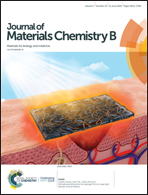A yellow-emissive carbon nanodot-based ratiometric fluorescent nanosensor for visualization of exogenous and endogenous hydroxyl radicals in the mitochondria of live cells†
Abstract
In this study, a ratiometric fluorescent nanosensor was developed for visualization of hydroxyl radicals (˙OH) in the mitochondria of live cells. The obtained nanosensor comprised of three functional moieties: amino-functionalized carbon nanodots (CDs) with bright yellow fluorescence acting as the reference element, the nanocarrier, coumarin-3-carboxylic acid (CCA), working as the specific recognition molecule toward ˙OH, and (4-carboxybutyl)-triphenylphosphonium bromide (TPP) serving as the directing moiety for mitochondria. The hybrid fluorescent nanosensor CCA@TPP@CDs only emitted the fluorescence of CDs at 577 nm upon excitation at 405 nm. However, after reaction with ˙OH, a new emission peak ascribed to the reaction products of CCA with ˙OH was clearly observed at 451 nm. Meanwhile, this peak gradually increased as the concentration of ˙OH was increased, but the emission at 577 nm of CDs remained unchanged, leading to the ratiometric detection of ˙OH. The developed nanosensor exhibited high sensitivity for ˙OH sensing with a broad linear range of 0.1–160 μM, and a low detection limit down to 70 nM. The nanosensor also showed high accuracy and excellent selectivity for ˙OH sensing against other reactive oxygen species and metal ions. In addition, the nanosensor demonstrated low cytotoxicity, good biocompatibility and mitochondria targeting ability. Based on these prominent properties, the developed nanosensor was successfully applied for monitoring exogenous and endogenous ˙OH in the mitochondria of live cells.



 Please wait while we load your content...
Please wait while we load your content...